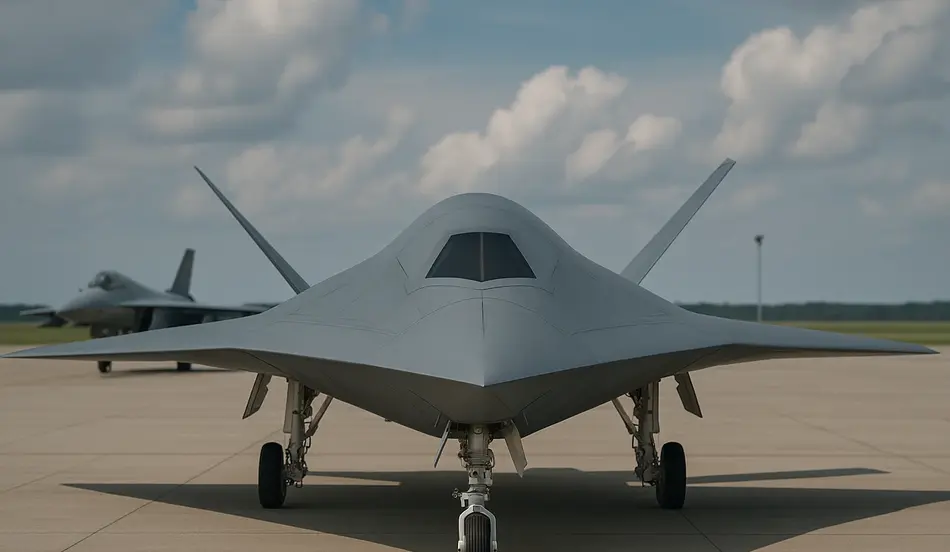Multiple startups and defense giants like Lockheed Martin are betting on a new crop of drones to be the future of war. Shield AI is at the forefront of this revolution with their X-Bat, an autonomous fighter jet that requires no pilot and is entirely powered by an AI system called Hivemind. This next-generation war fighter has capabilities to fly long distances, carry munitions, be fully autonomous, and be deployed anywhere defense needs it.
The X-Bat represents a significant leap forward in military technology, combining AI piloting with vertical takeoff and landing capabilities—something that has never been achieved together in a next-generation aircraft. Shield AI has already flown the F-16 autonomously, but the combination of AI piloting and vertical takeoff and landing in a single aircraft is unprecedented.
The Development Timeline: From Testing to Production
Shield AI has laid out an ambitious timeline for the X-Bat’s development and deployment. The first flight of the X-Bat is scheduled for 2026, with subsystem flights beginning that year and full system flights in 2027. The company has already been conducting engine testing, radar cross-section testing, and wind tunnel testing, with production expected to begin in 2029.
The development process involves extensive testing at Shield AI’s wind tunnel facility in San Diego, California, where they test 17% scale models of their aircraft in a tightly controlled environment. This allows them to measure lift, drag, and other aerodynamic properties before building the full-scale aircraft, which is crucial for making adjustments early in the development process when changes are still cost-effective.
The Cost Advantage: $27 Million vs. $100+ Million
One of the most compelling aspects of the X-Bat is its cost-effectiveness compared to traditional fighter jets. The company estimates that the X-Bat will cost about $27 million to produce, which is a fraction of what the military has previously been spending on fighter jets, especially when factoring in pilot training costs.
A report from Rand Corporation estimates that training a basic qualified pilot for an F-35 can cost over $10 million, in addition to the aircraft itself, which costs $80 to $100 million depending on the type. The X-Bat eliminates these pilot training costs entirely since it’s run by AI, making it significantly more economical for military operations.
The Pilot Shortage Crisis: AI as the Solution
The U.S. Air Force is already facing a pilot shortage, which is a highly skilled job requiring significant government investment. The X-Bat addresses this critical issue by eliminating the need for human pilots entirely. This is particularly important given the increasing demand for drone capabilities in modern warfare.
The company’s mission is to save the lives of service members with pilot-free aircraft, and the X-Bat represents a significant step toward achieving this goal. By removing humans from the cockpit, the military can deploy more aircraft without the constraints of pilot availability and training requirements.
The AI Software: Hivemind as the Foundation
Shield AI has long been focused on building drones, but now it’s hinging much of its future on the AI software that powers them. The Hivemind software is a cornerstone and foundation for everything the company does, serving as the long-term growth driver of the business because it enables the development of next-generation aircraft.
The software is designed to operate in contested environments, meaning it can function without GPS—a critical capability given that GPS jamming is a common defense tactic used by both Ukraine and Russia. Shield AI has already demonstrated this capability in Ukraine, where their V-Bat has conducted hundreds of operations while GPS and communications are jammed, providing long-range reconnaissance, intelligence, surveillance, and targeting operations.
Autonomy Meets Intelligence: The Future of Defense
Shield AI’s Hivemind software isn’t just guiding drones — it’s redefining how machines operate in contested environments. When GPS and comms go dark, Hivemind keeps missions alive. This is what the future of autonomous systems looks like — resilient, adaptive, and built for real-world conflict zones. The next generation of AI-powered defense starts here.
Discover AI Defense Careers →The Vertical Takeoff Advantage: Runway Independence
One of the key features of the X-Bat is its vertical takeoff and landing capability, which provides significant tactical advantages. The number one benefit of being able to take off vertically is that you are no longer constrained by runways, which are massive, stationary, expensive infrastructure targets for the enemy.
This capability allows the X-Bat to be deployed from virtually anywhere—it can be packed in the back of a truck, launched from small ships, or operated from remote locations without the need for traditional airfield infrastructure. This flexibility is crucial for modern warfare scenarios where traditional airfields may be compromised or unavailable.
The Competitive Landscape: A Crowded Market
Shield AI is relatively small compared to competitors like General Atomics and Anduril, who were selected by the U.S. Air Force in 2024 to develop a fleet of drones meant to fly alongside manned fighter jets. These companies beat out major players like Boeing and Lockheed Martin for development funding.
The concept of crewed-uncrewed systems is great in theory, but the industry is yet to see how this is practically implemented and how it performs on the battlefield. Shield AI differentiates itself by leveraging AI capabilities to ensure great mission outcomes for customers, particularly in contested environments where GPS is unavailable.
The Safety Concerns: Learning from Past Mistakes
Shield AI has faced challenges along the way, notably in 2024 when a U.S. service member’s fingers were partially severed during a drone landing accident. Forbes reported that the company had been overlooking safety precautions for years. The company has since focused heavily on safety and building it into the culture of the organization.
While there was some loss of confidence from customers following the incident, Shield AI has worked to recover and rebuild momentum. The company is now very confident in its ability to deliver great products that are safe, with safety being a top priority in all operations.
The Ethical Considerations: Human Control Over Lethal Force
Shield AI addresses concerns about AI-powered weapon systems by maintaining that autonomous systems should not make moral decisions about the use of lethal force. The company’s policy, which aligns with U.S. Military and NATO policy, ensures that humans remain in the loop for critical decisions.
As a former Navy SEAL who has had to make moral decisions about the use of lethal force on the battlefield, the company’s leadership believes that autonomous systems should not be making these decisions. This approach helps address concerns about “killer robots” while still providing the tactical advantages of autonomous systems.
The Global Drone Arms Race: China’s Dominance
The war in Ukraine has shed light on the explosion of drone deployments in modern warfare, with 70% of recent conflicts using drones. In 2010, only three countries possessed armed drones, but by 2025, this number has increased to 118 countries and continues to grow.
However, who actually wins from this drone arms race is China, because both Ukraine and Russia are using Chinese components to some extent. There has been a lack of American systems in the real battlefield, which presents an opportunity for companies like Shield AI to fill this gap.
The Future of Warfare: Millions of Drones
The company envisions a future where the USA fields millions of drones, with AI and autonomy being key to achieving this scale. As the company’s leadership notes, “I can’t field millions of drone pilots,” making autonomous systems essential for large-scale drone deployment.
This vision aligns with President Trump’s executive order “Unleashing American Drone Dominance,” which aims to accelerate commercialization of drone technologies and integrate them into the National Airspace System. The Big Beautiful Bill has allocated billions of dollars for unmanned aerial systems and AI development.
FAQ Section
Q: When will the X-Bat be deployed to battlefields?
A: Shield AI plans first flight in 2026, full system flight in 2027, and production in 2029.
Q: How much does the X-Bat cost compared to traditional fighter jets?
A: The X-Bat costs about $27 million to produce, compared to $80-100 million for traditional fighter jets, plus $10+ million in pilot training costs.
Q: Can the X-Bat operate without GPS?
A: Yes, the X-Bat’s Hivemind AI system can operate in contested environments without GPS, which is crucial for modern warfare scenarios.
Q: What makes the X-Bat different from other drones?
A: The X-Bat is the first airplane in the world that is AI-piloted and has vertical takeoff and landing capabilities, making it runway-independent and highly versatile.
The Bottom Line: A New Era of Autonomous Warfare
The X-Bat represents a significant leap forward in military technology, combining AI piloting with vertical takeoff and landing capabilities to create a new generation of autonomous fighter aircraft. While the development timeline extends to 2029, the potential impact on warfare is enormous.
By eliminating the need for human pilots, reducing costs, and providing runway independence, the X-Bat addresses critical challenges facing modern militaries while maintaining the tactical advantages of autonomous systems. As the drone arms race continues to accelerate, Shield AI’s X-Bat positions the company at the forefront of this technological revolution.




